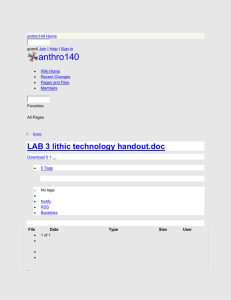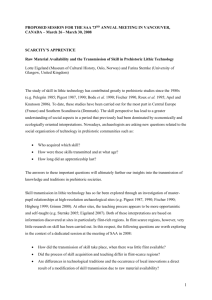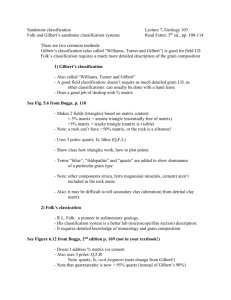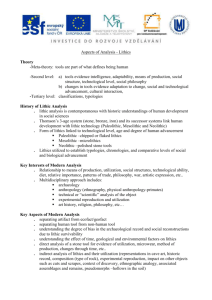The Lithic Stage - University of Minnesota Duluth
advertisement
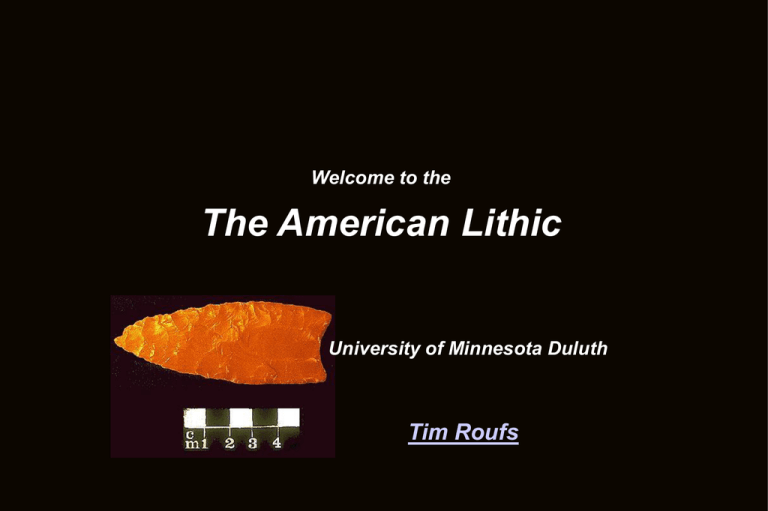
Welcome to the The American Lithic University of Minnesota Duluth Tim Roufs www.d.umn.edu/cla/faculty/troufs/anth3618/mastages_handout.html www.d.umn.edu/cla/faculty/troufs/anth3618/mastages_handout.html Text: Mexico (5th ed) Page 9 Mexico (5th ed.). Michael D. Coe and Rex Koontz. NY:Thames and Hudson, 2002, p. 9. Text: Mexico (5th ed) Page 9 Mexico (5th ed.). Michael D. Coe and Rex Koontz. NY:Thames and Hudson, 2002, p. 9. Text: Mexico, page 9 www.d.umn.edu/cla/faculty/troufs/anth3618/mastages_handout.html Mexico, Ch. 4, “The Preclassic Period: Early Villagers” Mexico, Ch. 3, “The Archaic Period” Mexico, Ch. 2, “Early Hunters” www.d.umn.edu/cla/faculty/troufs/anth3618/mastages_handout.html The Maya, Ch. 2, “The Earliest Maya” www.d.umn.edu/cla/faculty/troufs/anth3618/mastages_handout.html Mexico, Ch. 2, “Early Hunters” www.d.umn.edu/cla/faculty/troufs/anth3618/mastages_handout.html http://weber.ucsd.edu/~dkjordan/arch/mexchron.html#EarlyHunters Nine Important Points for the Lithic Stage After Willey and Phillips, Method and Theory in American Archaeology. Chicago: University of Chicago Press, 1970 Mexico, Ch. 2, “Early Hunters” www.d.umn.edu/cla/faculty/troufs/anth3618/mastages_handout.html http://www.d.umn.edu/cla/faculty/troufs/anth3618/ma_timeline.html#lithic Lithic Stage 1. Principle stage criteria: rough and chipped stone artifacts Tehuacán, Puebla this will later become famous for the origin of maize… Tehuacán Valley, Puebla, Mexico 4,200 ybp Early farming in the Americas Understanding Physical Anthropology and Archaeology, 9th Ed., p. 358 Lithic Stage 2. Natural Context: late glacial and early postglacial environments of the New World Lithic Stage the environmental contexts of the Late Pleistocene indicate a climate quite different from that of the present Lithic Stage this stage may have ranged from as early as 38,000 ? B.C. down to about 5000 B.C., although the later limit varies considerably • some suggest 7000 B.C. www.d.umn.edu/cla/faculty/troufs/anth3618/mastages_handout.html http://www.d.umn.edu/cla/faculty/troufs/anth3618/ma_timeline.html#lithic Lithic Stage 3. Evidences are most complete in Western North America • particularly in the High Plains http://www.odci.gov/cia/publications/factbook/reference_maps/north_america.html http://w3.trib.com/~wmuseum/colby.htm Lithic Stage 3. Evidences are most complete in Western North America • particularly in the High Plains • but also included is the Central Mexican Area and Taumalipas Lithic Stage 4. Two major technological traditions, or groups of traditions are postulated in the Lithic Stage . . . Lithic Stage 4.A. One is characterized by pressure flaking and lanceolate blades . . . Clovis Folsom Plano Dalton Major types of North American Paleo-Indian projectile points. Understanding Physical Anthropology and Archaeology (8th ed), p. 386 Life Nature Library, Early Man, p. 111 Lithic Stage e.g., Clovis points http://www.sdsmt.edu/wwwsarc/collectn/stone/clovis.html http://www.pbs.org/saf/1406/ http://www.kikipoo.com/indians/karankawa/new.htm http://www.ele.net/art_folsom/pre-clovis_2004/preclovis2004.htm Lithic Stage e.g., Angostura points http://www.csasi.org/2001_january_journal/cibolo_creek_site.htm http://www.d.umn.edu/archlab/Fish_lake.htm Lithic Stage 4.B. The other is characterized by percussion chipping and crude choppers and scrapers . . . Life Nature Library, Early Man, p. 110 Life Nature Library, Early Man, p. 110 Lithic Stage e.g., stone tools from the Tamaulipas Archaic are similar to this Lithic Stage 5. The percussion chipperscraper tradition may have earlier beginnings than the pressure-flaked-blade traditions . . . Lithic Stage Whether or not the percussion chipper-scraper tradition is older remains to be demonstrated as fact, but . . . there is good evidence that the two existed contemporaneously for a long time Lithic Stage Major Proponent for an “Early Lithic”: Alex Krieger Alex Krieger http://www.d.umn.edu/cla/faculty/troufs/anth3618/mastages_handout.html Alex Krieger www.d.umn.edu/cla/faculty/troufs/anth3618/mastages_handout.html Lithic Stage 6. The pressure-flaked-blade traditions are clearly best adapted to the ancient grassland environment of the Plains and the East . . . http://www.odci.gov/cia/publications/factbook/reference_maps/north_america.html Lithic Stage and (with the pressure-flaked-blade) to the hunting of large animals now extinct http://www.unmuseum.org/mastodon.htm Lithic Stage the percussion chipper-scraper traditions seem more at home in the semiarid environments of the Greater Southwest . . . http://www.odci.gov/cia/publications/factbook/reference_maps/north_america.html http://www.mnsu.edu/emuseum/archaeology/artifacts/gilapottery.html Lithic Stage . . . associated chipper-scraper) (with the percussion in the Greater Southwest with the economic pursuits of gathering Lithic Stage in some instances both the pressure-flaked-blade traditions and the percussion chipper-scraper traditions may appear in the archaeological assemblage of a single culture Lithic Stage e.g., Sta. Isabel Iztapán Sta. Isabel Ixtapán Lithic Stage 7. Both the pressure-flakedblade and the percussion chipper-scraper traditions show continuity into later cultures of the succeeding Archaic Stage . . . http://www.d.umn.edu/cla/faculty/troufs/anth3618/ma_timeline.html#lithic Lithic Stage . . . this is especially true of the percussion chopper- scraper traditions which carry on into the later Archaic Desert cultures of the Greater Southwest http://www.mnsu.edu/emuseum/archaeology/artifacts/gilapottery.html Lithic Stage 8. The origins of the Lithic culture in North America – unlike the Old World – are still fairly obscure • and it is not clear whether there was a “Pre-Clovis culture” • one which was here before stone tool making http://www.ele.net/art_folsom/preclvis.htm http://www.ele.net/art_folsom/pre-clovis_2004/preclovis2004.htm “pre-Clovis” 11,500 - 14,000 ybp Lithic Stage 9. Populations in the Lithic Stage were small and scattered, but by 5000 B.C. or before, humans had found their way over most of the New World http://www.odci.gov/cia/publications/factbook/reference_maps/north_america.html Lithic Stage Discussion Lithic Stage “Lithic” is not entirely satisfactory as a name, but evidence on this stage is predominantly of stone technology • there are, however, an increasing number of bone finds Lithic Stage the Lithic is the stage of adaptation by immigrant societies to the late glacial and early postglacial climatic and physiographic conditions of the New World Lithic Stage the effective working criteria are, therefore, associations of artifacts and other evidences of human activity in geological deposits • or with plant and animal remains which reflect these times and conditions Lithic Stage the nature of the finds indicates that the predominant economic activity of this stage, at least in certain areas, was hunting Lithic Stage • main emphasis was on large herbivores, including extinct Pleistocene forms • the Lithic is pre-eminently a hunting stage, although other economic patterns were certainly present Lithic Stage the general pattern of life was migratory in the full sense of the word Lithic Stage knowledge of the culture in the Lithic stage are few • lithic technology covers an immense range of rough and chipped stone traditions •but it does not include the practice of grinding and polishing Lithic Stage work in bone and horn is assumed to have been important, but the evidence has largely disappeared Tools and Technologies • lithic (stone) • bone, tooth, horn / antler Glossary osteodontokeratic osteo = "bone" donto = "tooth" keratic = "horn" Glossary osteodontokeratic osteo = "bone" donto = "tooth" keratic = "horn" Bone awl, Emeryville, CA. http://emeryville.wli.net/gallery/gallery2/bone_top_10_list.htm Glossary osteodontokeratic osteo = "bone" donto = "tooth" keratic = "horn" http://www2.sfu.ca/archaeology/museum/ask/a6.htm Glossary osteodontokeratic osteo = "bone" donto = "tooth" keratic = "horn" http://www.arts.uwaterloo.ca/ANTHRO/rwpark/ArcticArchStuff/TLArts.html Lithic Stage settlement and habitation patterns were such as to leave few traces in the ground Lithic Stage sociopolitical inferences for this stage are hazardous • a small-scale kinship type of organization is postulated, but within this generalization there is room for a high degree of variability Tehuacán Lithic Stage data do not support the view that because Lithic cultures are relatively simple they are also uniform • all parts of the continent were settled in these days, but trait lists suggest they were different Lithic Stage Lithic Sites include: Tehuacán Tamaulipas (Diablo and La Perra Phases) Tepexpan Sta. Isabel Ixtapán Tlapacoya Valsequillo Tequixquiac Tehuacán http://www.d.umn.edu/cla/faculty/troufs/anth3618/ma_timeline.html#lithic Lithic Stage Lithic Sites include: Tehuacán Tamaulipas (Diablo and La Perra Phases) Tepexpan Sta. Isabel Ixtapán Tlapacoya Valsequillo Tequixquiac Tamaulipas http://www.d.umn.edu/cla/faculty/troufs/anth3618/ma_timeline.html#lithic Lithic Stage Lithic Sites include: Tehuacán Tamaulipas (Diablo and La Perra Phases) Tepexpan Sta. Isabel Ixtapán Tlapacoya Valsequillo Tequixquiac Tepexpán Tepexpán http://www.d.umn.edu/cla/faculty/troufs/anth3618/ma_timeline.html#lithic Lithic Stage Lithic Sites include: Tehuacán Tamaulipas (Diablo and La Perra Phases) Tepexpan Sta. Isabel Ixtapán Tlapacoya Valsequillo Tequixquiac Sta. Isabel Ixtapán http://www.d.umn.edu/cla/faculty/troufs/anth3618/ma_timeline.html#lithic Lithic Stage Lithic Sites include: Tehuacán Tamaulipas (Diablo and La Perra Phases) Tepexpan Sta. Isabel Ixtapán Tlapacoya Valsequillo Tequixquiac Tlapacoya http://www.d.umn.edu/cla/faculty/troufs/anth3618/ma_timeline.html#lithic Lithic Stage Lithic Sites include: Tehuacán Tamaulipas (Diablo and La Perra Phases) Tepexpan Sta. Isabel Ixtapán Tlapacoya Valsequillo Tequixquiac Valsequillo http://www.d.umn.edu/cla/faculty/troufs/anth3618/ma_timeline.html#lithic Lithic Stage Tehuacán Tamaulipas (Diablo and La Perra Phases) Tepexpan Sta. Isabel Ixtapán Tlapacoya Valsequillo Tequixquiac Tequixquiac http://www.d.umn.edu/cla/faculty/troufs/anth3618/ma_timeline.html#lithic Tequixquiac Lithic Stage Lithic Sites include: Tehuacán Tamaulipas (Diablo and La Perra Phases) Tepexpan Sta. Isabel Ixtapán Tlapacoya Valsequillo Tequixquiac What happens next? http://www.d.umn.edu/cla/faculty/troufs/anth3618/mastages_handout.html http://www.d.umn.edu/cla/faculty/troufs/anth3618/ma_timeline.html#lithic And after that? Time line of “New World Civilizations.” Understanding Physical Anthropology and Archaeology, 8th ed., p. 479. End of The Lithic Continue on to Welcome to the The American Archaic University of Minnesota Duluth Tim Roufs

